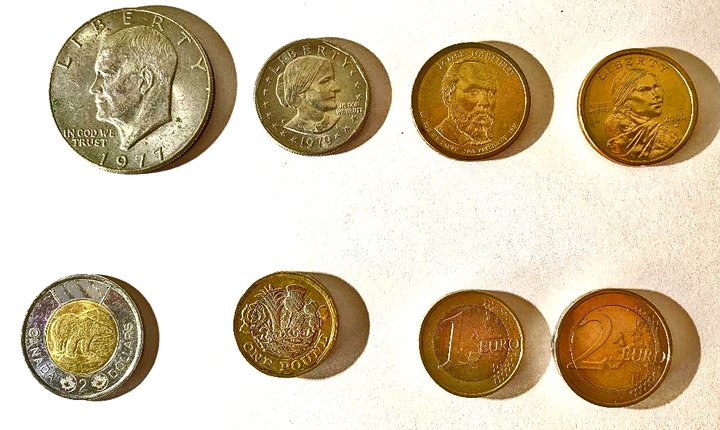Time to stop worrying about Covid, the election, rising sea level, murder hornets, the end of the world, etc. etc. Time instead to focus on the immediate problem, i.e. why we’re not using dollar coins? Every other country (well, Canada, Britain and the European Union) has their basic unit coins. Canada: Canadian dollar or “loonie;” Britain: twelve-sided pound; EU: the euro.
A dollar coin makes fiscal sense, since dollar bills cost four cents to make, and they last on average 18 months; dollar coins cost 8 cents to make, but last 30 years. Over those 30 years, eliminating dollar bills in favor of coins would save the country nearly six billion dollars.

Top: 1977 Eisenhower dollar; 1979 Susan B. Anthony dollar; 2011 James Garfield dollar; 2000 Sacagawea dollar. Bottom: 2016 Canadian toonie; 2017 UK pound; 2016 one-euro; 2018 two-euro.
So why don’t we use dollar coins? Several answers present themselves, including:
- They’re unfamiliar. Ever tried paying for something with a Susan B. Anthony coin? This SBA dollar coin was minted from 1979 to 1981, when production ceased due to poor public acceptance (probably because it looks and feels very much like a quarter). The mint tried again in 1999. Since then, we’ve had the Sacagawea dollar and several so-called Presidential and Native American dollars, but none of these is in common use today.
- The vending machine lobby. After reading about the opposition it has put up whenever the “replace bills with coins” issue surfaced, I wondered if perhaps they had their own constitutional amendment to protect their investments.
- Cash tills don’t have compartments for dollar coins. So if your dollar coin is accepted by, say, your local coffee shop, it’s going to be stuck at the back of the drawer and will go in the daily cash bag to the bank…to sit there.
- There’s no two-dollar coin. Note that Canada, Britain and the European Union all have two-somethings (the toonie, the £2, the €2). Which makes getting change for, say, five, that much easier.
- They’re heavier than bills! They don’t fit in a wallet (without a coin compartment)!
- There are a lot of dollar bills: nearly 12 billion of them (about 36 for every woman, man and child in this country). Strength comes in numbers!
Me, I love coins. They’re tangible—I like their heft, their shininess, the way they jingle. But acceptance will never happen, not in my lifetime. But here’s how to do it in case I’m wrong and Americans all wake up one morning shouting, “I want dollar coins and I want them now!”
- Mint both dollar and two-dollar coins. Make them totally different from each other and from existing coins. If you were blind, could you easily tell them by touch alone?
- Have a big advertising campaign so people are familiar with them before they actually go into circulation. (Check how the UK government prepared the population for the switch to decimal currency in 1971.) (I still miss the shilling and half-crown.)
- Support the vending machine industry by subsiding the design and manufacture of coin identification modules that can be switched with existing note trays.
- Phase out dollar bills fast—24 months maximum. After that, you have to go to a bank to cash them in.
- And while we’re at it: dump the penny, like Canada did in 2012. Here it costs 2.41cents to manufacture a 1-cent coin!
As I say, it’ll never happen. But a guy can dream…
CLICK TO MANAGE